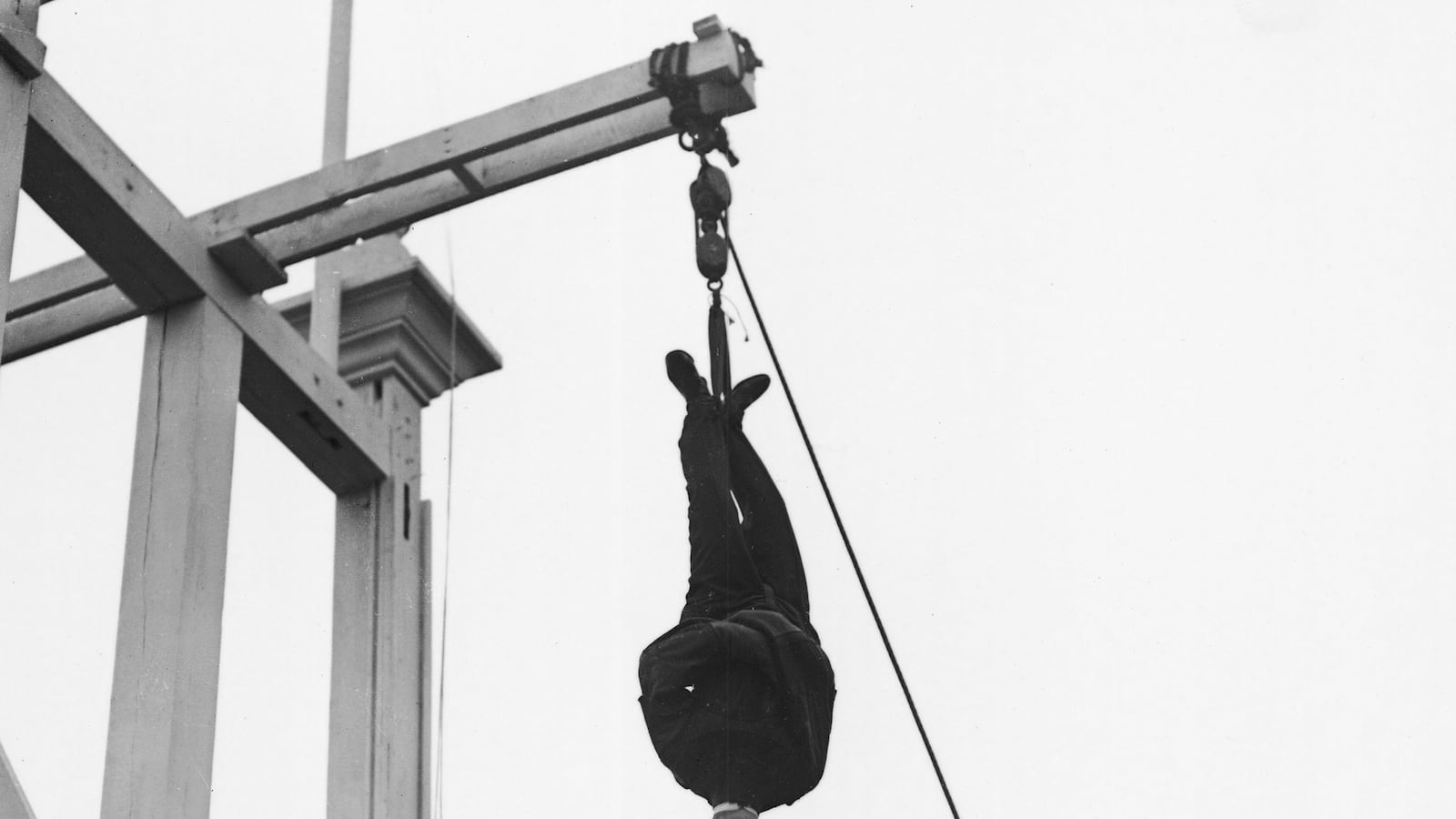In 1974, a small classified ad in an issue of Magic Magazine allegedly offered up an unusual prop for sale. A wooden box, slightly larger than 2 feet by 3 feet, with a quadruple-padlocked lid that secured a removable, oversized milk can inside. Built in 1909 and dubbed the Double Fold Death Defying Water Mystery, it was designed for the world’s greatest escape artist, a man who could slip out of anything—straitjackets, beer barrels, coffins, even the most secure jails.
The magical box entered Houdini’s repertoire as a stepping stone between his milk can escape trick and his famously elaborate Water Torture Cell. In the early 1910s, the Double Fold Death Defying Water Mystery was the centerpiece of Harry Houdini's world-renowned performances. He would fold himself into the milk can, which was filled with water by an assistant, and remain inside until the nerve-wracked audience was gasping for air, only to escape and emerge dripping wet, but unharmed.
Photos: Houdini's Bag of Tricks Up for Auction

For a good part of the next 100 years, the wooden prop pulled a stunt its owner would have been proud of: It vanished with barely a trace, only popping up a few times in the early decades. This was an unusual loss for an insular community of magicians and fans that carefully track the movements of historical artifacts, especially those belonging to the most famous escape artist and illusionist in history. By the 1940s, the box had disappeared from the show circuit entirely and was relegated to the rumor mill.
Until last summer, that is, when a surprise visitor from South Carolina drove into Chicago with the near-mythical Houdini prop in his trunk. Forty years prior, on September 17, 1974, Jack La Wain, proprietor of La Wain’s House of Magic in Illinois, had shipped the box to a magician-minister named Gary Collins and included a typed note with its history. The large wooden box had been sold in a string of acquisitions that traced back to the magician’s brother, Theo Hardeen, who inherited it after Houdini’s death, and who used it in his own performances two decades after his brother. (In one terrifying 1935 performance, Hardeen was trapped in the trick for over three minutes.) La Wain remembered first being offered the box by Hardeen after a show in New Orleans. The box slipped through his grasp then, but 20 years later, it resurfaced in New York in the hands of a Houdini Show performer who was selling off a storage warehouse full of props.
For 30 years Collins had been loading it into his Airstream trailer to use in his family’s traveling magic show, “Illusions of Grandeur,” staged in churches across the country. “Because I performed in churches, never at a convention, never wrote a book or lectured, to the magic community, I didn’t exist,” he explained in a recent blog post.
So when Chicago auctioneer Gabe Fajuri first got a cold call from Collins describing the box, he was skeptical. With a voice thick with tears, Collins told Fajuri he had stopped performing in 2000 and it was time to consign the piece. “I’m thinking, ‘Yeah, right,’” Fajuri remembers. “Nobody knew the thing still existed.”
After Fajuri acquired the box last year, he began gathering other memorabilia of the late, great magician. On Saturday, his magic-centric auction house, Potter & Potter, will open “Houdiniana,” a sale of 204 pieces related to Houdini and 82 more antique pieces of magical paraphernalia. The box is part of the auction, listed with a starting bid of $10,000, but it’s expected to go for at least double that, if not much more.
The other artifacts—from handcuffs to playbills to assistant costumes—poured in from across the country after Fajuri began seeking more items to fill out a small collection he'd been stashing away over the years. Among them are at least four finds that even the most knowledgeable Houdini hunters had never been able to track down, including the Double Fold Death Defying Water Mystery.
“I’ve known about this for 50 years, I’ve been looking for it for 40 years, and when it showed up everything really came into place," Patrick Culliton, author, collector, and one of the foremost experts on Houdini, says of the box. “We knew it wasn’t really lost, but we couldn’t find it.”
“There are just all kinds of items that haven’t come up in years or ever,” Culliton says, flipping through the auction catalog and offering his thoughts (“terrific stuff,” “a beautiful item,” “Teller may go for that”).
Also never-before-seen, “The Cologne Papers” unveil a slander lawsuit Houdini brought against a German newspaper and a policeman after they claimed that he’d tried to bribe an official to help with an escape stunt. The real goings on at the trial were, until now, “one of the last things about Houdini that nobody knew anything about,” Culliton says. Another, a four-page hologram instructional packet of a trick called The Black and White, has long been considered a “lost magic secret,” he says.
Perhaps the crown jewel of these undiscovered documents is a 125-page scrapbook Houdini kept on spiritualism that was picked up by a lucky collector at a flea market in what Fajuri describes as “one of those Antique Roadshow-oh-my-god-I-can’t-believe-it” moments.
An avid scrapbooker, Houdini collected posters and playbills and clippings, all annotated with his marginalia. Most of these were donated to the Library of Congress after his death. But this particular book, complete with notes calling out people as liars and haters (“Proves Munn is [unclear] & against me!”, “This is the minister who lied about Margery”) reveal a man who was deeply skeptical of spiritualism and made it his crusade to discredit mediums of the age who purported to interact with spirits.
Though Houdini’s career was cut short when he died in 1926 at the age of 52 after an ill-timed punch to the gut by a college student, his amazing abilities continue to mystify and fascinate. The auction comes at a particularly zeitgeisty moment for Houdini. His anti-sorcery beliefs were surely taken as inspiration for illusionist and spirit-skeptic character played by Colin Firth in Woody Allen’s latest film, Magic in the Moonlight (Fajuri recently tracked down the director’s address and mailed him an auction catalog). And on September 1, the History Channel will air a two-part miniseries starring Adrien Brody as the famous escape artist.
Culliton grew up in Los Angeles around the time that Harry Houdini’s widow died, and two garages worth of memorabilia were emptied out by the family’s lawyer. He distinctly remembers a new magic store that was literally giving away Houdini artifacts to get people in the door.
“There was a time when he was just sort of another dead magician,” Culliton says. “Vaudeville was dead, Houdini was dead—he was off the radar.”
The last personal effects from Houdini’s Manhattan brownstone were auctioned off in 1980 after a woman whose father had purchased the residence from Houdini’s widow died. The little-known auction attracted only a few magicians who’d kept an eye on the estate sale section of the paper for this specific purpose and spotted this: “Approximately 125 items of Houdini the world famous magician and escape artist found after being lost for 54 years,” a small advertisement in The New York Times read. Though his belongings had been mined for years (by collectors, but also supposedly unscrupulous plumbers and a sticky-fingered mind reader, according to Culliton), there were still discoveries being made in the cavernous basement of 278 W. 113th St., which Houdini had stuffed with thousands of items from his shows.
The finds were sold for a couple bucks—one scrapbook fetched $250—as they had been in the prior 50 years after his death. Fajuri says his auction, which is the most important large sale in a decade, has posters starting at $10,000 that were listed for $5 in the ’30s. “It’s the kind of stuff that would make you cry,” he says.
In true fashion, Houdini reemerged from the lull stronger than ever and with a captive audience, both on the auction circuit and in popular culture. “It never really went away—he was always good for a newspaper story his whole life and even after he died he was still good for a newspaper story,” Culliton says. “He was just the stuff of legends. By 1915 he was a household word. He was in the dictionary. He was a living legend.”
The man who once seemed to defy death entirely has held onto his reputation and accolades long after succumbing to his mortality. Even a century after his heyday, Houdini has maintained the same mystique he enjoyed while living.
“He had the good fortune of dying on Halloween,” Fajuri says. “It’s just mythology built up over time along with him being a real showman and publicity hound.” In what seems to be one last PR-savvy stunt, the non-believing Houdini even asked his wife, Bess, to hold a seance on the anniversary of his death that elicited rapt attention annually. Nearly 90 years later, a group of magicians still honors their idol with a “Broken Wand” ceremony at his gravesite each year.
This Saturday, Fajuri expects a similarly obsessed crowd in his auction showroom in addition to hundreds of people bidding online for his Houdini lots. The fans willing to plop down thousands of dollars on antique relics are a diverse bunch. “We have customers who are literally farmers,” Fajuri says. But the magic world’s headliners—the David Copperfields, the Penn and Tellers—have been known to swoop in and snatch up items of particular interest for their personal or museum collections. Ten years ago, Copperfield purchased Houdini’s Water Torture cell at a Las Vegas auction, and Culliton speculates he might have his eye on the newly unearthed box.
Culliton isn’t sure if he’ll break into his own piggy bank for the auction—many of the pieces offered filtered through his hands in the past years, he says. Besides, these things get heated quickly, and he can already guess which opposing Houdini collector he’d be raising his paddle against for the piece he’s got his eye on. “We got feverish about something a few years ago and we ran an $85 item into a $450 item on eBay,” he recalls of one bidding battle. Even for a bunch with the best tricks in the book to keep from drowning, only a master escape artist can survive the front lines of Houdiniana unscathed. “It can turn into Armageddon,” Culliton says.




